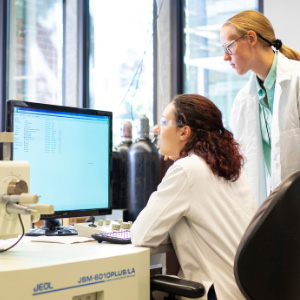Our department is at the heart of the materials revolution. Advances in materials have preceded almost every major technological leap since the beginning of civilization.

What is MSE?
Materials scientists are involved in every aspect of engineering.

Admission
There are several pathways to join the UW MSE undergradute program!
Your future career awaits
A degree in MSE can lead to fulfilling and successful careers in virtually every engineering industry. Hear real alumni tell us why they chose MSE, what they love about MSE, and how their degrees in MSE have impacted their careers.
Hear from our students

A different path
Evan Micelotta
Evan found MSE through YouTube videos and discovered a passion for manipulating materials.

A passion for nanoscience
Michel Bernardo
Michel transferred to the UW after a career personality test introduced her to nanoengineering.

A continuing journey
Brandon Lou
Brandon started as an undergrad, then joined our master's program, and is now pursuing a Ph.D., all here at UW MSE.
Features of the Undergraduate Program
We offer an ABET-accreditated Bachelor of Science (BS MSE) program that graduates the highest number of students per faculty member among peer departments nationwide.
Unique aspects of our program include:
- A degree option in Nanoscience and Molecular Engineering
- Active student professional organizations
- Diverse student body
- Small class size
- Hands-on, team-based learning
- Undergraduate research projects
UW MSE researchers have contributed greatly to the UW's success as a Most Innovative University. Between 2016-2025, MSE researchers reported 122 inventions disclosed, 77 patents filed, 23 licenses and 12 startup companies
Focus on student success
Preparing our students for the wide variety of jobs that await them is our highest priority. UW MSE students develop new materials, process methods, equipment, and material uses. Subjects include biomimetics and biomaterials; ceramic properties; composite materials; electronic, optical and magnetic materials; materials characterization, chemistry, modelling; metals & alloys; and polymers. Our graduates find employment in the aerospace, automotive, biomedical, chemical, construction, electronics, energy and telecommunication industries. We are proud to lay the foundations for successful careers in many sectors of the economy, from academia to industry.
Many of our graduates are admitted into top-caliber graduate schools – such as MIT, Berkeley, UCSB, University of Illinois, and Northwestern – and launch their careers in companies that lead the world in research and development, such as Boeing, Intel and Micron.
Frequently Asked Questions
Bioengineering and materials science and engineering both provide similar education in mathematics, chemistry, electronics and physics. The main difference between the two is that bioengineering focuses on integrating other engineering principles and solutions to solve biomedical problems, while materials science and engineering delves deeper into developing and understanding the properties of materials designed for applications in numerous advanced industries. For example, bioengineers could identify a need for a better hip replacement implant, and would understand the technological requirements to tackle this problem. Materials science engineers would be able to synthesize a new material and tailor its properties so the material would be compatible for that implant's application.
Materials scientists study the correlation between material composition, structure, processing condition, and property or performance to either create new materials or modify existing materials to improve their performance. A well-trained materials science engineer not only has a deep working knowledge of the properties of various materials such as metals, ceramics, composites and polymers, but also understands the needs and demands of other technological fields.
Bioengineering – an interdisciplinary area that bridges engineering, biology and medical sciences – is one of those other fields. It is a specialized field in engineering that involves defining healthcare problems and then leverage engineering solutions to tackle them. Bioengineers create devices and tools targeted toward biomedical and clinical applications. Common research interests for bioengineers include imaging modalities and associated software for disease diagnosis, organ-on-a-chip technologies for drug discovery, biosensors, artificially generated tissues/organs and so on. Since bioengineering research most often involves principles from different disciplines, bioengineers typically need to have broad knowledge and collaborate with scientists and engineers from other fields such as biochemistry, materials engineering, chemical engineering, and electrical engineering.
Material is the indispensable foundation of engineering; materials scientists and engineers work in all fields of chemistry, physics, and engineering. MSE focuses mainly on solid state materials through controlling the connections and arrangement of atoms to achieve desired properties for various engineering applications. When carbon is arranged in different forms, you get diamond, graphite, carbon nanotubes or graphenes. When a trace amount of alien atoms is introduced, you get n-type or p-type semiconductors, the bedrock of today’s electronics. Fiber composites for space and aviation, solar cells, lithium ion batteries, nanomaterials for biomedical applications, and quantum materials are a few examples materials scientists study.
Chemical engineering generally and primarily focuses on process design, reaction engineering, understanding parts within systems, and change across scale, from the nano-scale up to manufacturing large quantities. Chemical engineers are typically involved in process engineering and other large-scale manufacturing in a wide range of industries including biotechnology, clean energy, consumer packaged goods, advance materials and coatings, aerospace, and more.
Many students pursue careers in the field of materials Science and engineering because they love materials, and they want to be involved in the development of new materials for the future. But there can be some confusion about the differences between materials science and engineering and mechanical engineering.
A degree in materials science and engineering combines engineering, physics and chemistry principles to solve real-world problems. Graduates with this degree will have deep knowledge of many types of materials (e.g., metals, polymers, ceramics, liquid crystals, composites), which enables them to contribute to fields like nanotechnology, biotechnology, information technology, energy, advanced manufacturing methods and other major engineering disciplines. One of the most valuable qualities of this degree is that it combines experience in materials processing and structure to control the properties of materials and their performance in a variety of environmental conditions. If you want to be considered an expert on materials, then materials science and engineering is definitely the right choice.
A degree in mechanical engineering is more broad and much less focused on materials. Mechanical engineering combines physics and mathematics, and involves training on fluid systems, thermal systems, mechanical systems, etc. Simply put, mechanical engineers learn about materials as well, but certainly with much less detail. You might consider that they use materials, but they generally are less involved in designing materials to survive specific applications. Mechanical engineers are also capable of working in a variety of fields including biotechnology and health, environmental engineering and energy, transportation, manufacturing, and information systems.
The discovery, understanding, and use of new materials by humans has led to every technological advancement we have today. With the surge of two-dimensional and topological materials, the boundary between MSE and physics has been blurred.
Physics focuses on fundamental principles. The curriculum is designed to prepare a student with a solid understanding of how everything moves and interacts in the most simplistic and idealistic way. Physics undergrads learn the details of classical mechanics, electromagnetism, quantum mechanics, solid state physics, topology and other electives as a basis of knowledge. The study of real materials (which are full of disorders and impurities) doesn’t kick in until junior or even senior year. However, with a good understanding of the microscopic mechanisms, you will see how these idealized and oversimplified models describe the properties of real materials in a quite precise fashion.
In MSE, you will gain similar knowledge but with a focus on the application, and have opportunities to make close connections to industry. In a way, the curriculum is almost the reverse of physics. You will first learn about the classification of materials, notable properties, and phenomenological models. After having a global picture of the whole field, you delve into the physics of use-inspired materials. If you are interested in computing and data storage materials, you will learn about solid-state physics and electromagnetism; if you are interested in polymers, you will learn about statistical mechanics and thermodynamics; if you are interested in biomaterials for tissues and organs, you will learn about microbiology; etc. In these specialized topics, you will learn to analyze the materials in a thorough manner, where anything from the constituents to their functionalities will be taught in an elaborate way. In this sense, MSE provides more choices for a first- or second-year student who is undecided on their future career path.